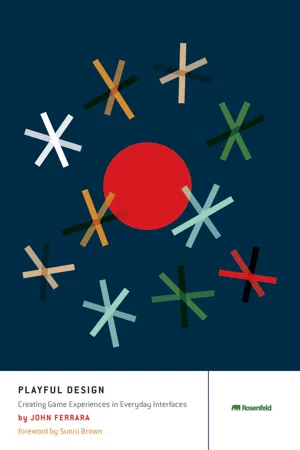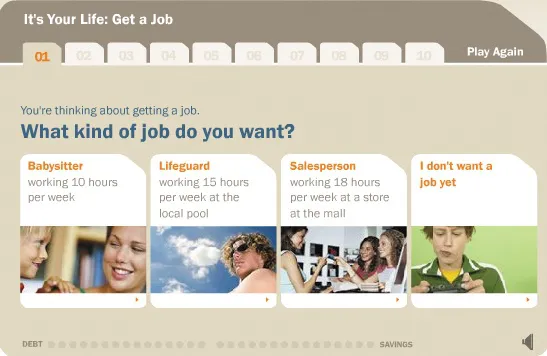
This is a test
- 245 pages
- English
- ePUB (mobile friendly)
- Available on iOS & Android
eBook - ePub
Book details
Book preview
Table of contents
Citations
About This Book
Game design is a sibling discipline to software and Web design, but they're siblings that grew up in different houses. They have much more in common than their perceived distinction typically suggests, and user experience practitioners can realize enormous benefit by exploiting the solutions that games have found to the real problems of design. This book will show you how.
Frequently asked questions
At the moment all of our mobile-responsive ePub books are available to download via the app. Most of our PDFs are also available to download and we're working on making the final remaining ones downloadable now. Learn more here.
Both plans give you full access to the library and all of Perlego’s features. The only differences are the price and subscription period: With the annual plan you’ll save around 30% compared to 12 months on the monthly plan.
We are an online textbook subscription service, where you can get access to an entire online library for less than the price of a single book per month. With over 1 million books across 1000+ topics, we’ve got you covered! Learn more here.
Look out for the read-aloud symbol on your next book to see if you can listen to it. The read-aloud tool reads text aloud for you, highlighting the text as it is being read. You can pause it, speed it up and slow it down. Learn more here.
Yes, you can access Playful Design by John Ferrara in PDF and/or ePUB format, as well as other popular books in Ciencia de la computación & Interacción persona-computadora. We have over one million books available in our catalogue for you to explore.
Information
Part II. Designing Game Experiences
Chapter 5. Ten Tips for Building a Better Game
- 1. Games Need to Be Games First
- 2. Playtest, Playtest, Playtest
- 3. Games Don’t Have to Be for Kids
- 4. Action Can Be Boring
- 5. Fit the Game into the Player’s Lifestyle
- 6. Create Meaningful Experience
- 7. Don’t Cheat
- 8. Skip the Manual
- 9. Make the Game Make Sense
- 10. Make It Easy to Try Again
- Play to Your Strengths
“Okay,” you say, “I’m ready.”
You’re a seasoned designer with a long history of creating compelling user experiences. You see the advantages that games can offer to UX design. You like (maybe even love) the idea of building an iPhone game to serve as a tour of a historic park, a social media game for Facebook to organize a political campaign, or a freestanding Flash game to teach basic physics on an educational website. You even have a rough concept of what that game might be like. You may be in a position to get funding for the project within your company or to pitch the idea to a receptive client. You want to start putting your ideas down on paper, get development under way, and speed toward launch.
That’s an awesome place to be. Vision and ambition are written into the opening lines of all success stories. But there are some risks to jumping in too quickly. Game development is very time-consuming and resource-intensive. It can be difficult to make a significant change in direction if you discover midway through development that some of your initial ideas aren’t translating into the great gameplay experience you had in mind.
So before getting started and running with it, you need a primer to point you in the right direction, to steer you clear of the most common mistakes, and to maximize your chances of success. This is the chapter for you. Though the challenges of building an enjoyable game shouldn’t be oversimplified, the 10 general guidelines I present here will at least help you refine your ideas and break through some of the common barriers that could otherwise hold back your design.
1. Games Need to Be Games First
This point may sound too obvious, but it can be very easy to miss. And missing it is often the undoing of a well-intentioned design. You can design games to teach and persuade (as discussed later), but if such real-world objectives supersede meaningful gameplay, they will undermine your chances for success. First and foremost, a game needs to be enjoyed.
The Schwab MoneyWise It’s Your Life game has a noble mission: to convince people to save more money for retirement and other long-term objectives. Much like the original Game of Life board game, It’s Your Life presents players with a number of choices between spending or saving money over the course of a simulated lifetime (Figure 5-1). At the end, players get a letter grade to represent how well they did.

CHARLES SCHWAB CORPORATION
Figure 5-1. At each step in Schwab’s It’s Your Life game, it’s pretty obvious which choice will lead to a winning outcome.
The problem is that the game’s designers were much more interested in hammering home their message than creating an actual game experience. If you want to win the game, then the right choice each step of the way is to save your money and not spend any of it. Ever. On anything. That means you can earn an A+, the highest possible score, if you:
- Skip college
- Never move out of your parents’ house
- Never get married
- Never have children
- Never travel or take any vacations
- Work indefinitely past age 65
- Die alone with lots of money and no one to leave it to
I’m sure the designers reasoned that people playing through the scenarios would elect to do valuable things with their lives, but they set up the game so that doing nothing with your life while saving vigorously is a sure way to win. Separating what people should do from what gets rewarded destroys the intended message. Even though It’s Your Life is packaged as a game, it isn’t committed to being experienced as a game.
2. Playtest, Playtest, Playtest
As much as we all know that testing is absolutely, completely indispensable in user interface design, I must stress (grammar be damned) that it is even more absolutely, completely indispensable when you’re designing a game. Even though every UX designer’s mantra is “test, test, test,” it’s still worth saying that you really must not neglect to playtest your game early and often.
The reason testing is so important in game development is that most video games are highly dynamic experiences. The flow of events changes from moment to moment, and each decision the player makes leads to a multiplicity of outcomes. Most games are also programmed with an element of randomness, so the same player never has quite the same experience twice. Multiplayer games throw even more unpredi...
Table of contents
- Playful Design: Creating Game Experiences in Everyday Interfaces
- How to Use This Book
- Frequently Asked Questions
- Foreword
- Introduction
- I. Playful Thinking
- II. Designing Game Experiences
- III. Playful Design in User Experience
- A. Acknowledgments
- B. About the Author
- Index